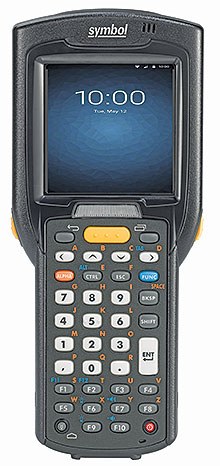The MC3100 Series of handheld mobile computers was introduced 2014 as an updated version of the very popular MC3000/MC3100 Series. With probably over a million MC3000/MC3100 units sold over the years, there was no need to change the form factor of this versatile mid-range handheld computer. Instead, the emphasis was on technology updates and enhancements that leverage the inherent, field-proven usefulness of this device and also add some interesting new capabilities.

So what's new? First, the MC3200 is faster. Motorola Solutions, the enterprise division of which is now part of Zebra, upgraded its midrange platform from the 624MHz version of the Marvell PXA320 chip to either an 800MHz or 1.0GHz version of an unspecified Texas Instruments OMAP dual-core processor. That's a good move for two reasons.
First, while the PXA320 and its predecessors once dominated the handheld computer market, Marvel failed to keep the PXA line relevant. Second, the TI OMAP chip can run both Windows and Android, and the MC3200 takes advantage of that. Zebra offers the device with either Microsoft Embedded Compact 7 or with Android 4.1.
The MC3200 has four times as much RAM and four times as much Flash storage as the MC3100, WiFi now supports the faster 802.11n in addition to 802.11a/b/g. On the data capture side, the SE950 1D laser of the original MC3100 has been replaced with the SE965, and the SE4500 2D imager with the SE4750. Both offer longer range reading. The SD card slot has been replaced by a microSD slot.
What hasn't changed is the basic form factor. This means that most MC3000 and MC3100 Series peripherals and accessories work with the MC3200, a big plus for existing customers. What also hasn't changed is the somewhat unique square 320 x 320 pixel touch screen that measures 3.0 inches diagonally. And as before, customers can select from three different keypads (28-key numeric, 38-key shifted alpha, and 48-key alpha-numeric) and also three different physical configurations (standard "straight shooter" imager or laser, rotating gun turret laser, and pistol grip versions).
On the battery side, "smart" 18 watt-hour Li-Ion pack that includes information indicators that show remaining charge and overall battery health, has been joined by a smaller (and lighter) 10.1 watt-hour battery.
In terms of size and weight, the standard MC3200 with an integrated scanner is still 7.5 inches long, 3.2 inches wide, and a maximum of under two inches thick. It weighs just under a pound. The turret laser and pistol grip versions are a bit bulkier.
The MC3200 is a rugged device that can survive multiple 4-foot drops, survived 500 tumbles from about two feet, and it can operate within an extremely wide temperature range of -4 to 122 degrees Fahrenheit. The device carries an IP54 ingress protection rating, which means it is protected against dust and also against water spray from all directions.
The unit also carries FIPS 140-2 certification, which addresses US Federal requirements where cryptographic type of security systems will be used.
The accelerometer, what the company calls "Enterprise-class Interactive Sensor Technology," enables all sorts of motion-based applications, including dynamic screen orientation (useful when dealing with customers), things like automatic logging of drops, or even power savings (device turns off when no motion is sensed for a period of time).
Overall, the MC3200 represents a well-executed update and enhancement of the company's venerable but still very popular MC3x00 platform. Able to use all of the MC3000 family's accessories and peripherals, the MC3200 now offers more processing performance, faster communication, and updated data capture technology. Like its predecessors, the MC3200 excels in ergonomics with its replaceable keypads, and in backroom functionality with its wealth of modular mounting, charging and expansion accessories.
How does the MC3200 compare to Zebra's MC9500? The latter is a top-of-the-line ultra-rugged model that's also a bit larger and heavier, and offers WWAN and full VGA screen resolution. The MC3200 is more of a mid-range device that is smaller, weighs less, and is designed primarily for retail and similar applications that do not require the same degree of ruggedness and sealing. The MC3100 also costs quite a bit less (US$1295-1,995 vs. US$2,495-3,295)



